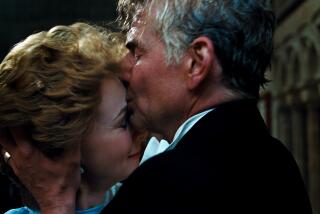Mezzo-soprano Cathy Berberian is due for a rediscovery
“Berberian Sound Studio” — the creepily offbeat new British independent film in which Toby Jones plays a timorous sound-effects specialist working on a ‘70s Italian horror flick — takes its title and inspiration from the late American mezzo-soprano Cathy Berberian. That’s the least director Peter Strickland, whose title for the film is a new music in-joke, could do. But it is also the minimally least we can do to remember the singer who changed singing perhaps more than any vocalist since the 18th century castrato Farinelli turned Handel’s and other Baroque composers’ musical heads.
This year marks the 30th anniversary of Berberian’s death from a heart attack at 57 in Rome, where she was about to appear on television to sing the “Internationale” in the style of Marilyn Monroe on the centennial of Karl Marx’s death. For evidence that her legend lasts, you need only witness “Berberian Sound Studio” (even if it has nothing to do with the actual singer) or Luciano Berio’s “Recital for Cathy,” which the Los Angeles Philharmonic performed last season.
And there is Kanye West’s “Yeezus,” released just this week. No, I don’t imagine the rapper would credit a dead, white sometimes opera singer as a direct influence, but any singer — any singer — who today pushes the envelope has Berberian DNA buried somewhere deep in his or her vocal cords.
PHOTOS: Arts and culture in pictures by The Times
Even so, Berberian has been neglected, especially by the record companies that have allowed many of her notable releases to slip out of print. “The Unforgettable Cathy Berberian,” a CD compilation in which she can be found bringing something special to Baroque music and avant-garde Berio and the Beatles, is so forgotten, for instance, that it is “currently unavailable” on Amazon.
But there is now an excellent website at cathyberberian.com. Take advantage of its links to rare audio and video (especially to the engrossing documentary “Music Is the Air I Breathe”). Head over to the extraordinarily useful UbuWeb.com. Poke around YouTube. You will be astonished.
What Berberian did was to make the unnatural natural. That she seemingly encompassed the whole world of singing and song was only a start. She also extended vocal techniques dramatically and thus the dramatic potential of singing. And she did all this with a sense of grace, humor, immediacy and grandeur never before found in the same vocal package.
In a 1978 appearance on the BBC show “Desert Island Discs” (you can link from her website), she noted that she sang in 36 languages and was ready for more. She failed to mention, however, her collection of French pornographic porcelain, but you can’t get everything into a 45-minute show. If fact, you can barely scratch the surface.
There seemed nothing Berberian couldn’t do in song. As a young, Juilliard-trained singer who was born in Massachusetts, she went to Milan, Italy, on a Fulbright Fellowship to study opera in 1949. There she immediately met and married Berio, who was a young composition student. Together they changed the course of music. Berio wrote works, such as the 1961 “Visage,” a pioneering tape piece that uses Berberian’s voice and electronics, which Strickland cites as having most inspired him and in which she evokes every emotion for which the human voice is capable.
PHOTOS: Celebrities by The Times
With near instantaneous radical shifts from, say, laughter to outrage to terror to sexual gratification, Berberian also explored a new range of vocal techniques and possibilities, the kinds of things that have filtered down to singing everywhere. There is no text, but you are never uncertain of her intent. By connecting an emotion to its opposite, she and Berio accomplish, in a way not displayed before in music, the complexity of the psyche.
But Berberian could do this not only because she was the avatar of avant-garde singing, which she was. She could do it because she was a uniquely complete singer. She berated the conservative classical music world for not embracing the new, and likened singers who worried only about pretty production to cows. But she also berated the avant-garde scene for its lack of openness, especially to pop culture.
She inspired Berio’s “Folksongs,” his extraordinary 1964 arrangement of international folk material for Berberian that was a radical move for the avant-garde at the time. The piece also became a private, deeply moving way for her and Berio to explore their breakup, which occurred at the same time. The piece is now a classic.
She then went on to record Beatles songs in the style of Baroque music, and from this crossover was born (and has never been bettered). She helped make Kurt Weill respectable.
Her intonation was flawless and she made every word matter whether in recitals of salon music or classical Lieder. She could be a wonderful comedienne when she turned to numbers from operetta or a dangerous seductress in the Habanera from “Carmen.” She became a Monteverdi specialist, beloved by the early music champion Nikolaus Harnoncourt, when nonspecialist singers wouldn’t go anywhere near the period-practice movement.
She loved comic strips and translated Jules Feiffer and Woody Allen into Italian with Umberto Eco. She wrote her own wild pieces, such as “Stripsody,” that paved the way for and still outclass some of the more recent attempts at musical pop art.
She did it all. Check her out.
More to Read
The biggest entertainment stories
Get our big stories about Hollywood, film, television, music, arts, culture and more right in your inbox as soon as they publish.
You may occasionally receive promotional content from the Los Angeles Times.







